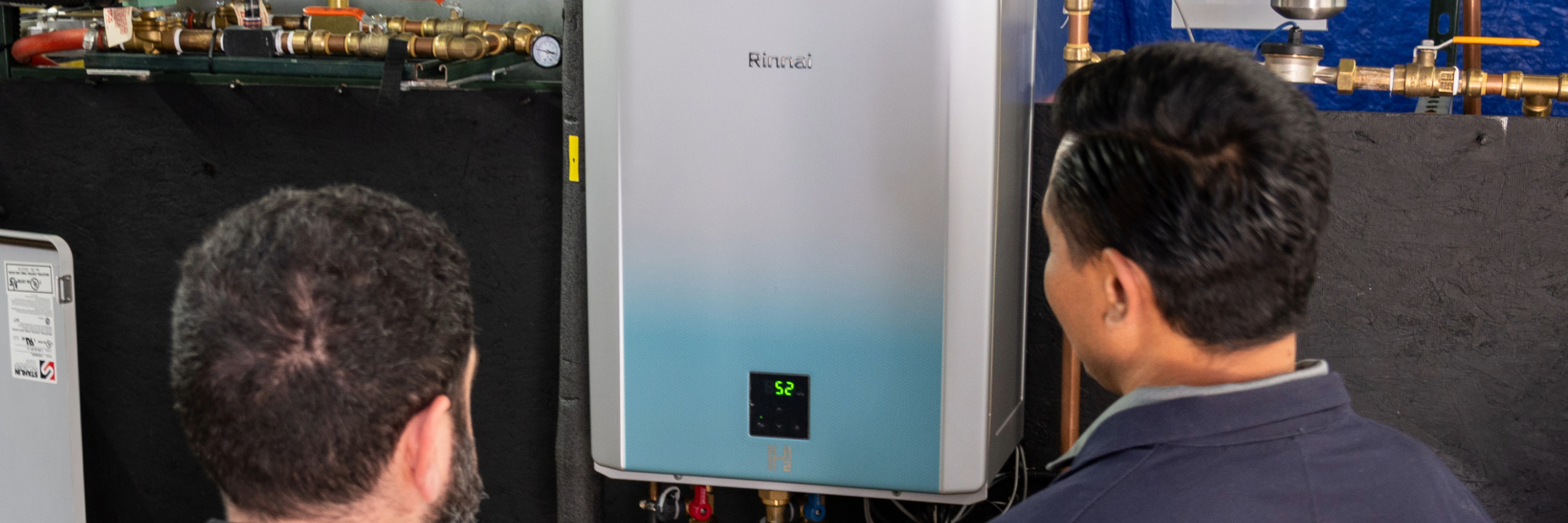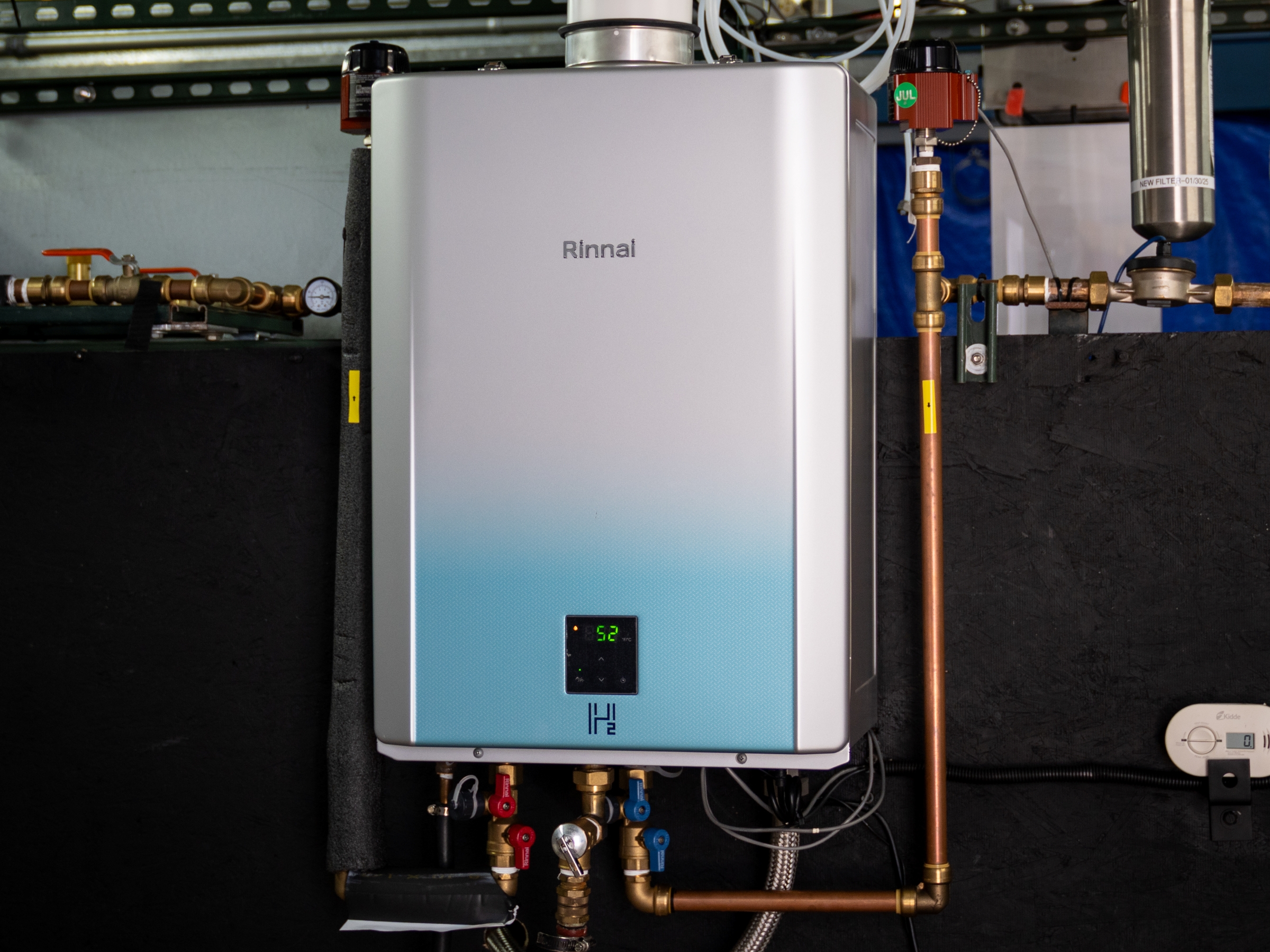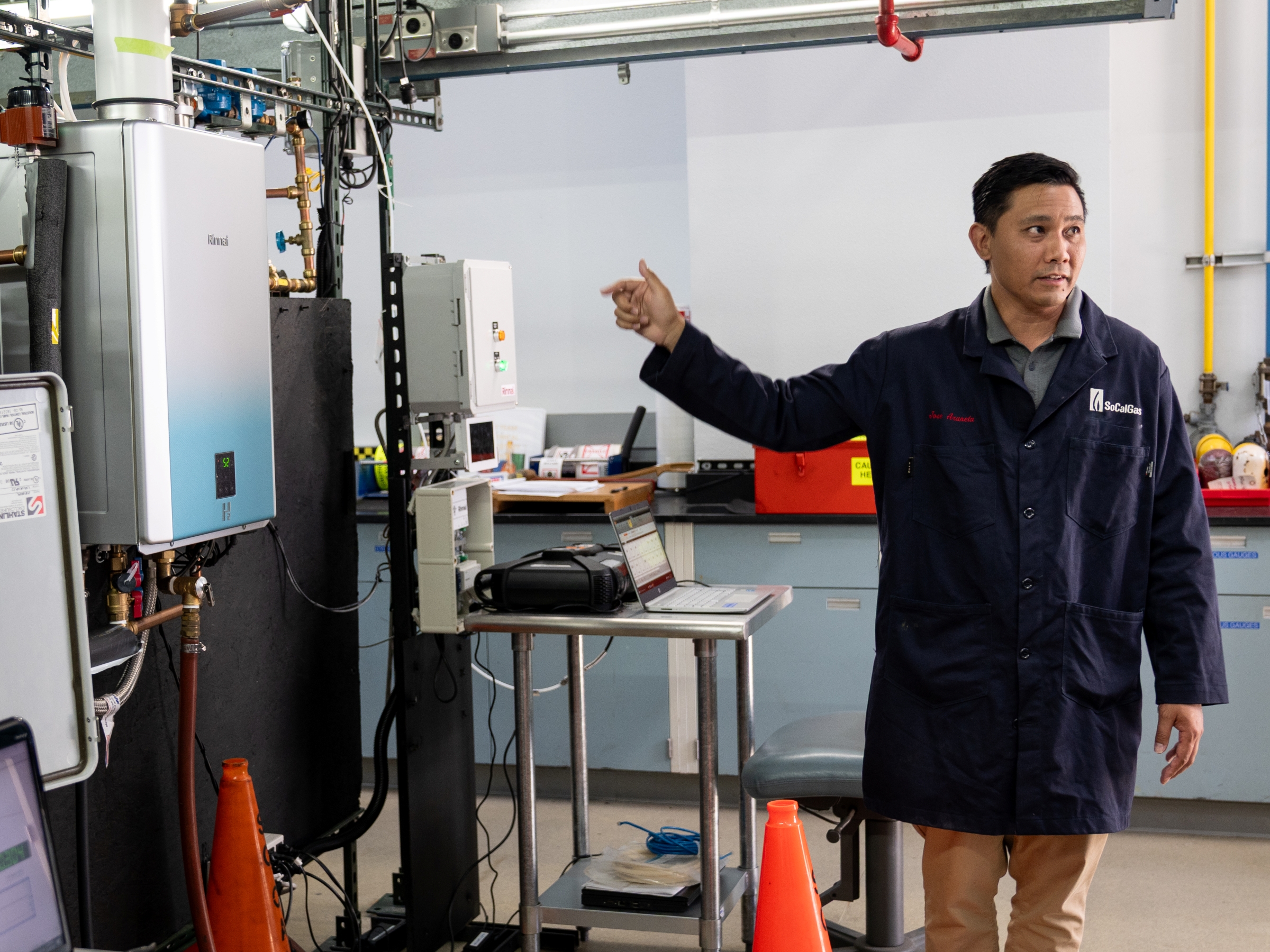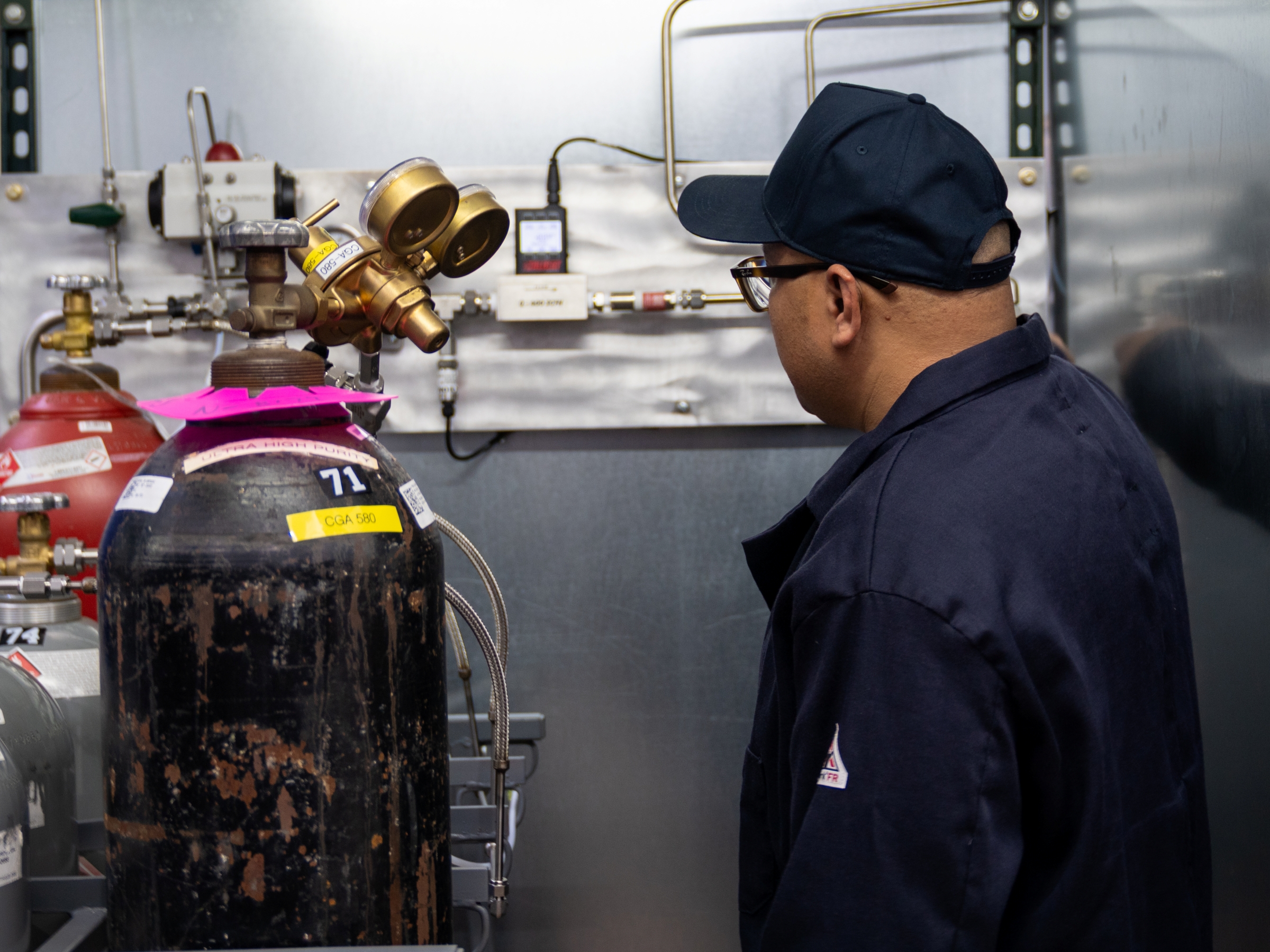
SoCalGas Demonstrates North America’s First 100% Hydrogen-Powered Tankless Water Heater
Nov 4, 2025
SoCalGas has successfully powered up North America’s first 100% hydrogen-fueled tankless water heater, marking an important step in exploring hydrogen’s future role as a zero-carbon energy source for residential use. The demonstration is part of SoCalGas’ broader efforts to support the advancement of decarbonized energy technologies.
Developed and provided by Rinnai Corp., the prototype unit was installed and tested at SoCalGas’ Engineering Analysis Center (EAC) in Pico Rivera, Calif. SoCalGas engineers have demonstrated that the unit performs safely and reliably, heating water using only hydrogen as fuel. The unit is not yet commercially available.
Unlike traditional water heaters that store hot water in a tank, tankless water heaters heat water only when needed, offering greater energy efficiency and space savings.
The demonstration serves as a proof of concept to explore how pure hydrogen combustion technology could potentially be applied in residential settings in the future.
The research demonstration has enabled engineers to collect and analyze data to evaluate safety protocols for hydrogen appliances, while monitoring the unit’s efficiency, performance and emissions. This data is being shared with Rinnai to support the future development of end-use hydrogen appliances.
“This collaboration with Rinnai is a great example of how we’re helping advance the development of hydrogen technology,” said SoCalGas Manager of Energy Programs and Strategy Darren Hanway. “We’re proud to support innovation that could potentially help reduce carbon emissions and expand efficient energy options for customers.”
Because hydrogen produces zero carbon emissions when burned, with water vapor as its primary byproduct, it holds promise as a key component in achieving a carbon-neutral future. SoCalGas is conducting research projects like this one to help lay the foundation for safe, reliable, and scalable hydrogen applications.
The EAC serves as SoCalGas’ primary laboratory for hydrogen research. Engineers there have conducted a wide range of demonstrations, including appliance safety assessments, leak detection studies, compressor performance evaluations, and materials compatibility research.
One notable initiative at the EAC is the Living Lab project, a NYSEARCH and SoCalGas RD&D collaboration which examines the impacts of higher concentrations of blended hydrogen on gas piping materials and various aspects of gas engineering and operations. By simulating real-world conditions, the project helps advance understanding of hydrogen blending infrastructure and its potential role in future energy systems.
SoCalGas is committed to delivering safe, reliable and affordable energy today, while exploring solutions that make us ready for tomorrow.
Photo Gallery
About SoCalGas
SoCalGas is the largest gas distribution utility in the United States, serving more than 21 million consumers across approximately 24,000 square miles of Central and Southern California. Our mission is: Safe, Reliable, and Affordable energy delivery today. Ready for tomorrow. SoCalGas is a recognized leader in the energy industry and has been named Corporate Member of the Year by the Los Angeles Chamber of Commerce for its volunteer leadership in the communities it serves. SoCalGas is a subsidiary of Sempra (NYSE: SRE), a leading North American energy infrastructure company. For more information, visit SoCalGas.com/newsroom or connect with SoCalGas on social media @SoCalGas.
This news blog contains forward-looking statements within the meaning of the Private Securities Litigation Reform Act of 1995. Forward-looking statements are based on assumptions about the future, involve risks and uncertainties, and are not guarantees. Future results may differ materially from those expressed or implied in any forward-looking statement. These forward-looking statements represent our estimates and assumptions only as of the date of this blog news. We assume no obligation to update or revise any forward-looking statement as a result of new information, future events or otherwise.
In this news blog, forward-looking statements can be identified by words such as “believe,” “expect,” “intend,” “anticipate,” “contemplate,” “plan,” “estimate,” “project,” “forecast,” “envision,” “should,” “could,” “would,” “will,” “confident,” “may,” “can,” “potential,” “possible,” “proposed,” “in process,” “construct,” “develop,” “opportunity,” “preliminary,” “pro forma,” “strategic,” “initiative,” "target," "outlook," “optimistic,” “poised,” “positioned,” “maintain,” “continue,” “progress,” “advance,” “goal,” “aim,” “commit,” or similar expressions, or when we discuss our guidance, priorities, strategies, goals, vision, mission, projections, intentions or expectations.
Factors, among others, that could cause actual results and events to differ materially from those expressed or implied in any forward-looking statement include: decisions, denials of cost recovery, audits, investigations, inquiries, ordered studies, regulations, denials or revocations of permits, consents, approvals or other authorizations, renewals of franchises, and other actions, including the failure to honor contracts and commitments, by the (i) California Public Utilities Commission (CPUC), U.S. Department of Energy, U.S. Internal Revenue Service and other regulatory bodies and (ii) U.S. and states, counties, cities and other jurisdictions therein where we do business; the success of business development efforts and construction projects, including risks related to, as applicable, (i) negotiating pricing and other terms in definitive contracts, (ii) completing construction projects or other transactions on schedule and budget, (iii) realizing anticipated benefits from any of these efforts if completed, (iv) obtaining regulatory and other approvals and (v) third parties honoring their contracts and commitments; changes to our capital expenditure plans and their potential impact on rate base or other growth; changes, due to evolving economic, political and other factors, to (i) trade and other foreign policy, including the imposition of tariffs by the U.S. and foreign countries, and (ii) laws and regulations, including those related to tax; litigation, arbitration, property disputes and other proceedings; cybersecurity threats, including by state and state-sponsored actors, of ransomware or other attacks on our systems or the systems of third parties with which we conduct business, including the energy grid or other energy infrastructure; the availability, uses, sufficiency, and cost of capital resources and our ability to borrow money or otherwise raise capital on favorable terms and meet our obligations, which can be affected by, among other things, (i) actions by credit rating agencies to downgrade our credit ratings or place those ratings on negative outlook, (ii) instability in the capital markets, and (iii) fluctuating interest rates and inflation; the impact on affordability of our customer rates and our cost of capital and on our ability to pass through higher costs to customers due to (i) volatility in inflation, interest rates and commodity prices and the imposition of tariffs and (ii) the cost of meeting the demand for lower carbon and reliable energy in California; the impact of climate policies, laws, rules, regulations, trends and required disclosures, including actions to reduce or eliminate reliance on natural gas, increased uncertainty in the political or regulatory environment for California natural gas distribution companies, the risk of nonrecovery for stranded assets, and uncertainty related to emerging technologies; weather, natural disasters, pandemics, accidents, equipment failures, explosions, terrorism, information system outages or other events, such as work stoppages, that disrupt our operations, damage our facilities or systems, cause the release of harmful materials or fires or subject us to liability for damages, fines and penalties, some of which may not be recoverable through regulatory mechanisms or insurance or may impact our ability to obtain satisfactory levels of affordable insurance; the availability of natural gas and natural gas storage and transportation capacity, including disruptions caused by failures in the pipeline and storage systems or limitations on the injection and withdrawal of natural gas from storage facilities; and other uncertainties, some of which are difficult to predict and beyond our control.
These risks and uncertainties are further discussed in the reports that the company has filed with the U.S. Securities and Exchange Commission (SEC). These reports are available through the EDGAR system free-of-charge on the SEC's website, www.sec.gov, and on Sempra’s website, www.sempra.com. Investors should not rely unduly on any forward-looking statements.
Sempra Infrastructure, Sempra Infrastructure Partners, Sempra Texas, Sempra Texas Utilities, Oncor Electric Delivery Company LLC (Oncor) and Infraestructura Energética Nova, S.A.P.I. de C.V. (IEnova) are not the same companies as the California utilities, San Diego Gas & Electric Company or Southern California Gas Company, nor are they regulated by the CPUC.




